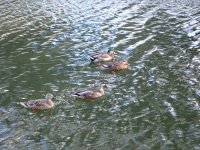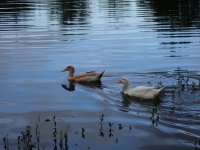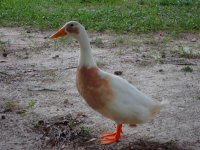Was this photo taken with a cell phone? It seems to be over-emphasizing black colors a bit, so take the parts of my comment that refer to blackness with a pinch of salt:
There are (at least) two interesting birds in the photo.
Starting with the farthest from the camera, the nearly-wild-colored male with the half-green head, which must be the one you were asking about. That half-green head pattern is pretty common in hybrid American Black Duck x mallard males. I'm guessing it might also show up in Mottled Duck x mallard males, and in central florida it's going to be a challenge to differentiate those two. But the bird has a few other oddities. First off, most of its plumage is much closer to mallard than to black duck or Mottled. A first-gen hybrid would usually show browner plumage, with dark mottling on each feather. Maybe it's a second-generation back-cross. (mallard x ABD and mallard x mottled hybrids are fertile.) Also, the body looks much chunkier than the other ducks it's with. Notice how high the rump sits out of the water. That's a sign of domestic ancestry. Finally, the front of the head has some odd dark markings in front of the eye and around the bill. You can see hints of that kind of pattern in female and non-breeding mallards, and in male black and mottled ducks, but this one is remarkably strong, especially for a breeding male (half-or-three-quarter) mallard. I'm not sure if that's common in hybrids, or if it's due to domestic ancestry, or if I'm just over-analyzing a photo artifact. But from what I can see, I'm guessing second-generation cross: mostly mallard, including domestic, with 1/4 either black or mottled - I'll just pick mottled, and Joern will be along soon to tell me why I'm wrong.
Next bird toward the camera: mallard female, or at least predominately mallard. Orange bill with a dark "saddle" pattern, blue speculum with black-and-white borders, white tail.
Skipping to the farthest-left bird, closest to the camera. We can't see the speculum, but it's otherwise very similar to the female mallard we just considered. White tail means it's a mallard... but it's got a strong dark spot at the corner of the bill, the head's maybe a little paler than the other bird, and the throat seems pale and unstreaked. So I'm wondering about some Mottled Duck ancestry there.
Finally, the bird second from the camera. The wing color and white tail say "mallard male". The bill color confirms it's male. But the body plumage is weird (too brown for wild breeding male mallard, too pale for wild non-breeding male mallard or for mottled or black duck) and the head pattern is quite strange. The head is similar to the first bird we described, except this bird has no green sheen. This bird also has a white collar on the neck, which is almost normal for male mallards, but the shape of this one looks strange to me. A lot of this could be explained by domestic ancestry, but I'm thinking there's some mottled duck hybridisation too. I'm going out on a limb and saying this bird is a close relative of the first bird I described. In fact it's possible the whole group forms a family.







